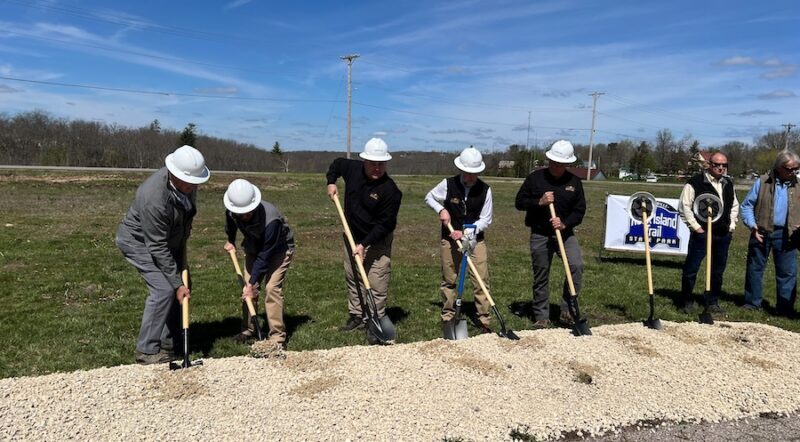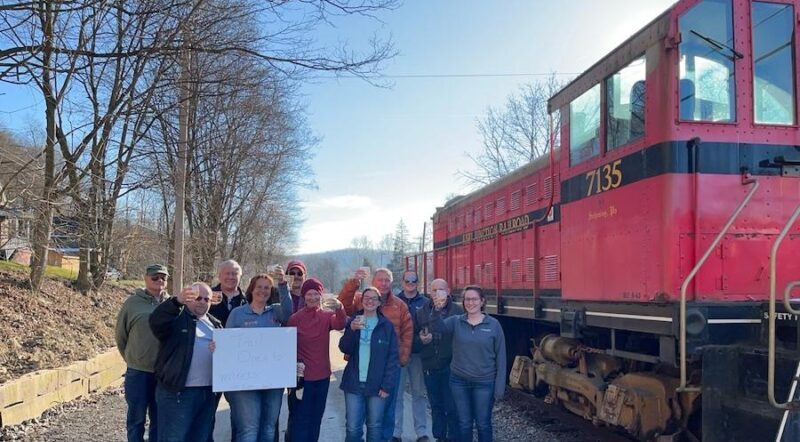Railbanking
MCT Goshen Trail | Photo courtesy Metro East Park & Recreation District
Railbanking, established in 1983 as an amendment to Section 8(d) of the National Trails System Act, is a voluntary agreement between a railroad company and a trail sponsor (such as a trail organization or government agency) to use an out-of-service rail corridor as a trail until a railroad might need the corridor again for rail service. This interim trail use of railbanked corridors has preserved thousands of miles of rail corridors that would otherwise have been abandoned.
Railbanking takes place during the rail corridor abandonment process, and official negotiations with the railroad can begin only after the railroad submits an initial notification to abandon the line to the Surface Transportation Board (STB). Any qualified private organization or public agency that has agreed to maintain the corridor for future rail use is eligible to negotiate for railbanking. During negotiations, the railroad is permitted to remove all its equipment and materials, except for bridges, tunnels and culverts, from a corridor.
If railbanking negotiations fail, the railroad will usually proceed with line abandonment. If negotiations succeed, a railbanking agreement will be established, and the railroad will turn the corridor over to the qualified private organization or public agency. This property transfer precludes abandonment. In other words, because a railbanked corridor is not considered abandoned, it can be sold, leased or donated to a trail manager without reverting to adjacent landowners.
The railroad has the right to re-establish rail service on a railbanked corridor. Should that occur, the trail-managing agency ordinarily is entitled to fair market compensation from the railroad seeking to re-establish rail service. However, to avoid disputes, this issue should be specifically addressed as a contingency in the initial contract with the railroad.
Related: Central Author of Historic Trail Legislation Named 2018 Doppelt Family Rail-Trail Champion
History
Resources Radio podcast with Peter Harnik, cofounder of the Rails to Trails Conservancy
Host Margaret Walls talks with Peter Harnik, cofounder of the Rails to Trails Conservancy, about grassroots and legislative efforts to repurpose abandoned railroad lines as recreational trails. Harnik discusses why the United States has so many abandoned railroad lines, the process of converting a railroad line into a trail, and the legislation that provides funding for trail projects.
In 1916, at the peak of the United States’ construction and development of rail lines, more than 275,000 miles of track crisscrossed the country, carrying freight and passengers and fueling the economy and growth of the nation. But by the 1950s and 1960s, railroads faced increasing competition from trucking companies, and costly federal regulations made it even more difficult for the railroads to compete. In fact, nearly a quarter of the nation’s railroad lines were operating under bankruptcy by the early 1970s.
The Staggers Rail Act, passed in 1980, deregulated the railroads and made it easier for them to abandon lines. Although railroads were then able to streamline their operations and diversify successfully, this deregulation also triggered a mass wave of rail line abandonments. Before deregulation, 38,000 miles of track were abandoned in the 45 years from 1930 to 1975. Yet, in the next 15 years until 1990, railroads abandoned nearly double that amount—65,000 miles—in only a third of the time.
In the early 1980s, Congress became concerned about the dramatic decline in the nation’s railroad infrastructure. With so many railroads abandoning corridors, it became apparent to Congress that something needed to be done to preserve the nation’s rail system for future transportation uses. In 1983, Congress amended Section 8(d) of the National Trails System Act to create a program to preserve rail corridors (called “railbanking”), through which corridors that would otherwise be abandoned can be preserved for future rail use by converting them to interim trails. The old, inactive railroad route survives but is re-purposed for other—potentially temporary—trail uses.
Opponents of railbanking have unsuccessfully challenged the constitutionality of the railbanking provisions of the National Trails System Act. In 1990, the Supreme Court unanimously ruled, in the case of Preseault v. United States, that preserving a corridor for future rail use through railbanking is a legitimate exercise of governmental power. This decision protects a railroad’s legal right to transfer all forms of its ownership, including easements, to a trail group. A more thorough examination of the legal issues that often arise with railbanked corridors, as well as an overview of how some of those issues have been resolved, can be found in RTC’s Rails-to-Trails Conversions: A Legal Review.
Opponents also periodically attempt to stop implementation of the railbanking provisions through legislative restrictions on trail development. RTC remains vigilant in monitoring legislative and legal assaults on railbanking and continues to build support in favor of the railbanking statute.
Why Railbank?
A rail corridor generally has several ownership types along its length. A railroad may have purchased some of the corridor “in fee,” meaning it acquired an ownership interest in the land; it may have purchased some easements, giving it only the right to use the land; or it may have acquired the right-of-way through federal grants. Occasionally, there is no information about how the railroad acquired the property (for example, when the property has been acquired through adverse possession or condemnation). These ownership differences are largely irrelevant to a railroad while the corridor is in active railroad use. Once a railroad decides to abandon a corridor, however, these ownership distinctions become important.
Upon abandonment, under the law of some states, the railroad may lose any rights to possess or transfer parcels of land within the corridor to which it merely held as an easement and whose use is limited to railroad purposes. At this point, even though the corridor may appear unchanged, it may no longer exist as a right-of-way, and the owners of the underlying land (often adjacent landowners) regain full rights to the corridor. In these cases, acquiring a corridor can become incredibly complex because it may be owned by many different people.
A corridor that is railbanked, on the other hand, precludes abandonment, and railbanking preserves the railroad’s right to transfer all forms of ownership, including easements, to a trail group. This arrangement can be very beneficial to the railroad company because it’s able to sell the entire corridor instead of pieces, therefore reducing transaction costs, and allows the railroad to avoid the expense of removing railroad structures such as trestles and culverts. It also prevents time-consuming and costly inquiries or litigation to resolve ownership questions.
Railbanking equally benefits trail organizations, whose acquisition of the corridor might otherwise be vulnerable to ownership challenges. The lowered costs to the railroad as a result of railbanking should be a factor in negotiating a lower purchase price. In addition, trail managers are in a position to resist attempts by railroads to employ an “across the fence” valuation methodology that does not take into account the railroad’s inability to demonstrate fee simple title to the corridor.
Definitions
Railbanking: Condition allowing a railroad to “bank” a corridor for future rail use if necessary. During the interim, alternative trail use is a viable option.
Surface Transportation Board: The federal agency that oversees changes made by railroad companies. Formerly the Interstate Commerce Commission (ICC).
Resources
‣ Manual – Acquiring Rail Corridors: A How-To Manual (See chapter 6, “Can You Take Advantage of Railbanking?”)
‣ Manual – Secrets of Successful Rail-Trails, (See chapter 7, “What to Do if the Line is Soon to be Abandoned”)
‣ Fact Sheet – Railbanking Fact Sheet
‣ Report – Railbanking and Rail-Trails: A Legacy for the Future
‣ Article – Rails-to-Trails Conversions: A Legal Review
Railbanking Stories
View More BlogsTrailNation Collaborative
TrailNation™ Collaborative is a nationwide peer learning community from Rails to Trails Conservancy that brings together advocates, leaders and professionals from across disciplines to establish and accelerate trail networks across America. The collaborative provides proven tools, methods and resources, combined with RTC’s expertise and network of partners across the country, to accelerate the development of connected trail systems. When trails are connected across regions and states, trail networks have a proven transformative impact—they are essential infrastructure that creates thriving, healthier communities.


